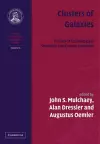
Clusters of Galaxies
3 contributors - Paperback
£44.00
John S. Mulchaey's research has focused on groups of galaxies. In 1993, he used the ROSAT telescope to show that diffuse X-ray emission is a common feature of many galaxy groups providing some of the strongest evidence to date that such systems are dominated by dark matter. More recently he has played an important role in the discovery and study of 'fossil groups', massive systems that contain very few galaxies. Alan Dressler has made many fundamental contributions to the study of large scale structure in the universe over the last 30 years, including the quntification of the so-called morphology-density relation in clusters. He also played a leading role in the discovery of the Great Attractor and massive black holes in nearby galaxies. More recently, he participated in the MORPHS project, using Hubble Space Telescope images to show that bursts of star formation were much more common in galaxies 5 billion years ago than they are today. Augustus Oemler has devoted much of his research career to understanding how galaxies have evolved to their present form. In collaboration with H. Butcher, he showed that clusters at intermediate red-shifts contain a large excess of blue galaxies (now known as the Butcher-Oemler effect). As a member of the MORPHS team, Oemler has more recently been using HST to study the morphologies of galaxies in moderate red-shift clusters. He recently finished a seven year term as director of Carnegie Observatories.